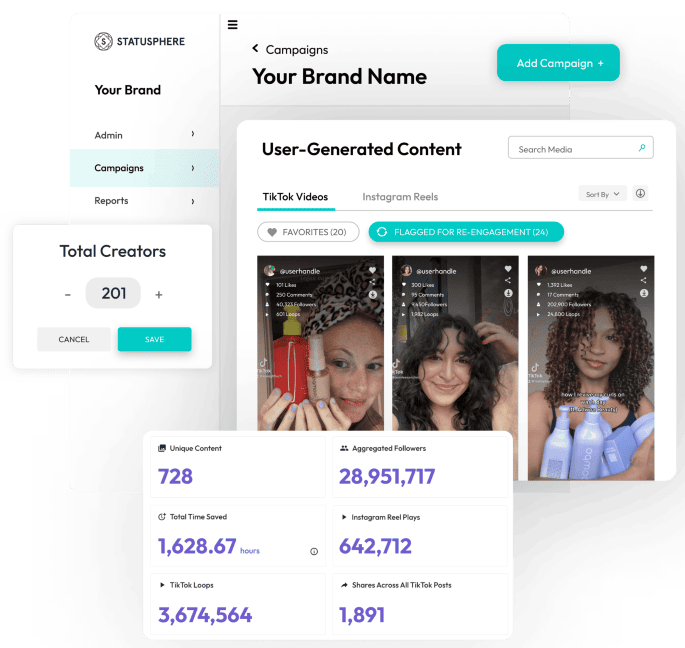Influencer Database Template: How to Build Yours (Spreadsheet & Tips)
This influencer database template can keep your in-house creator campaigns organized. We share our tips and a template for building your database of...
Is an influencer database a smart way to scale your campaigns? This post breaks down the pros and cons of influencer database software that brands need to know.


Does influencer database software make sense for your team?
|
Skip to Section 👇 |
Influencer database software refers to directories with information about social media influencers, including:
With all the details above in one place, brands can (theoretically) save time hiring influencers.
Think of an influencer database as an advanced search engine that helps brands find creators.
Using keywords related to your industry (ex: “parenting”) or product (ex: “cloth diapers”), you can highlight a list of influencers that might be a good match. Brands can then narrow their search by filtering creators by variables such as platform, price point or engagement rate.
The boom of influencer marketing has created a new wave of influencer platforms for brands. This includes tools like Statusphere that don't require you to dig for creators DIY. Our software programmatically matches brands with creators using 300+ first-party data points.
Most "platforms" out there are actually databases. In terms of how to choose an influencer database, there are a few crucial points to consider.
Below we’ve broken down the key details and features to consider for any given database software.
Some databases simply aggregate influencer information from across social media. Others represent their own influencer network. There are pros and cons to both.
For aggregators, you’re essentially paying for information you could find yourself with some digging. It’s a trade-off in terms of time versus money. Databases with built-in networks will typically have more engaged and dedicated influencers. That said, the pool of talent will be smaller.
We’ve seen databases claim to be as large as 30 million creators.
Quick question: do you really need a database of influencers larger than the population of Australia?
Probably not. Also, consider that there's no way a database can audit the accuracy and authenticity of that many creators. On the flip side, networks that are too small might lack the types of influencers you want to reach.
Again, it’s a trade-off.
Note: there's no "right" answer when it comes to how large an influencer network should be. That said, we've managed to scale our own network to tens of thousands of creators to help consumer brands find influencers across even the most niche industries. As our network has grown, we've been able to keep up with vetting our creator community for authenticity and accurate engagement rates.
Influencer databases typically require an annual contract. For reference, most database software costs between $750 and $2,000 per month to access. You’ll need to factor this into your influencer marketing budget on top of compensating your creators.
Databases can get pretty granular when it comes to their search features. Most platforms let you search by factors such as engagement rate and keywords by default.
Some databases actually identify an influencer’s past collabs to highlight brands they've worked with.
More advanced databases can assign influencers a compatibility score to see how your brand aligns with them. Features such as lookalike audiences and suggested creators are popular, too.
Using this type of software to find influencers can save serious time given how intensive influencer matchmaking can be. That's why we built Statusphere's unique algorithm to streamline the process using 250+ unique, first-party data points.

Organization is one of the key benefits of using a database. While some software will totally tie you to their platform, other apps will allow you to download and export your own list of contacts. This makes it easier to align your database with existing creator campaigns.
Again, the whole point of influencer database software is to save you time.
Features like visual search and content previews let you see what an influencer is all about without having to leave your database. Live previews (similar to those in the TikTok Creator Marketplace) help identify relevant influencers at a glance.

Now that we know what databases can do, let’s look at the upsides of investing in one.
Consider the legwork involved when it comes to finding Instagram influencers.
Digging through hashtags. Retrieving emails from bios. Combing through captions.
Then, apply the same search process to TikTok, YouTube and anywhere else you might be looking for influencers. That’s a lot of bouncing around, right? With a database, you can speed up many of these steps by having these details front and center in one place.
Databases allow you to filter influencers by engagement rate or follower size. This makes it easier to find micro-influencers or creators that meet a specific threshold when it comes to audience engagement. Instead of crunching these numbers yourself, databases can highlight them for you.
Most databases have influencers’ email addresses listed so you don’t have to hunt down their contact information. This is a time-saver, too. Keep in mind though that not all creators prefer to be contacted the same way. For example, contacting Instagram influencers might involve DMs, email or even a contact form.
For opt-in databases, you can approach influencers with a sense of confidence. That's because they acknowledge that they want to hear from brands. This doesn’t necessarily apply to aggregated databases. Pricier platforms will purge their influencer lists to ensure quality among their network.
As highlighted above, databases definitely their downsides. Many of them fly under the radar for brands until they're after they've been onboarded. Below we break down the cons to consider:
At the end of the day, a database is a database. Nothing more, nothing less.
That means you’re still on the hook for the most intensive and time-consuming aspects of running an influencer campaign. This includes:
Translation? You’re still managing relationships with influencers yourself. Even the best influencer database software out there can’t eliminate all of the legwork above. Fulfillment in particular!
As noted earlier, the cost of database software varies from platform to platform. There are stripped-down platforms that cost ~$200 per month while others are $4,000+ per month.
Considering that most services are billed annually, that’s a big commitment. This is especially true since this doesn’t include the cost of actually compensating influencers. If you plan on hiring hundreds of creators, the time and money involved in compensation (even with free products) can be massive.
Since you’re still on the hook for outreach, there’s no guarantee that database access will result in content. Your pitch still needs to land and you’re still responsible for managing creators.
This level of investment without guaranteed content is risky to say the least.
To get your money’s worth, you need to be consistently reaching out to and following up with influencers. We know firsthand just how time-consuming this can be.
Why pay for database access if you aren’t going to make the most of it? Doing so means hiring a dedicated team member to handle the process. In our experience, it takes up to 70 hours to run a product gifting campaign featuring 30 creators. That's being generous.
Could you save some time with a database when it comes to research and outreach? Absolutely.
But again, there are still so many time-consuming tasks on your plate after conducting outreach.
Imagine taking the time to craft pitches for potential influencers only to have emails bounce back.
Bummer. It happens more often than you’d think, though.
If the database you’re using isn’t updated regularly, influencers' information can quickly get outdated. Note that Meta's recent crackdown on third-party data scraping is having a huge impact on many databases' ability to compile accurate creator info.
Also, consider that content creators rebrand and change careers all the time. Reaching out with old information won’t just hurt your chances of a collab: it’s a bad look for your brand.
It’s difficult to gauge an influencer’s authenticity at a glance. You really need to dig into their content or even talk to them personally if you want to verify that they’re legit.
Thing is, fake followers and bot activity are issues that databases don’t always detect. Unless each influencer is being vetted individually, there’s a risk of running into “influencers” with inflated metrics.
Think about it. How does an influencer database service possibly vet millions of influencers by hand?
The short answer: they can’t.
The key takeaway here? Database software is truly a matter of “you get what you pay for.”
As long as you understand the requirements and expectations of managing your campaigns with a database, they can be valuable. Databases definitely save you time versus doing everything by hand.
Let's say you've outgrown the in-house approach but don't want to commit to a database. If you're laser-focused on seeing ROI in the form of guaranteed posts from creators, Statusphere can help.
Our micro-influencer marketing platform matches brands with creators from our vetted network of creators. Unlike other platforms and databases, Statusphere guarantees content for your brand and eliminates the time-intensive tasks involved with matchmaking and fulfillment.

Statusphere has already generated 75,000+ pieces of authentic creator content on behalf of 400+ brands. As an added bonus, we don't require our brands to endlessly scroll through a database.
Want to learn more about how our platform works? Get in touch with one of our experts to see how we can help you scale your influencer marketing efforts in a fraction of the time
This article was first published in June 2021. It was last updated June 23, 2023.

This influencer database template can keep your in-house creator campaigns organized. We share our tips and a template for building your database of...
Can't choose between influencer databases and influencer marketing platforms? Here's everything you need to know to find the best fit for your brand.
Time for a crash course in influencer collaboration! Here are the biggest dos and don'ts of influencer marketing brands should mind when...
Be the first to know about the latest tools, trends and strategies in influencer marketing for brands.